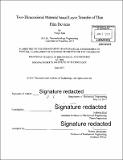| dc.contributor.advisor | Jeehwan Kim. | en_US |
| dc.contributor.author | Kim, Yunjo | en_US |
| dc.contributor.other | Massachusetts Institute of Technology. Department of Mechanical Engineering. | en_US |
| dc.date.accessioned | 2017-10-04T15:06:39Z | |
| dc.date.available | 2017-10-04T15:06:39Z | |
| dc.date.copyright | 2017 | en_US |
| dc.date.issued | 2017 | en_US |
| dc.identifier.uri | http://hdl.handle.net/1721.1/111747 | |
| dc.description | Thesis: S.M., Massachusetts Institute of Technology, Department of Mechanical Engineering, 2017. | en_US |
| dc.description | Cataloged from PDF version of thesis. | en_US |
| dc.description | Includes bibliographical references (pages 40-42). | en_US |
| dc.description.abstract | The semiconductor industry has mainly centered around silicon-based technology due to its associated cost advantage stemming from the abundance of the element and well-established fabrication infrastructures. However, there exists a plethora of compound semiconductors that offer unique electronic properties that can enable high performance devices superior to silicon for a wide range of device applications. Unfortunately, compound semiconductors industries have seen limited adoption in industries except in occasions where silicon-based technology cannot be used. This is mainly due to the rarity and high production costs associated with alternative semiconductor wafers. There have been many proposals that attempt to reduce the cost of production of these compound semiconductors by offering reusable wafers. In this scheme, the wafer is used as a platform to fabricate devices, the device layer is subsequently exfoliated from the wafer via a layer transfer allowing for the wafer to be re-used for continuous fabrication of thin-film devices. However, the layer transfer techniques that have been proposed so far often damages the wafer substrate, limiting their reusability and adding additional costs for surface refurbishment processes. This thesis proposes a novel layer transfer process, termed two-dimensional material based layer transfer (2DLT), which prepares thinfilm semiconductors by facile mechanical exfoliation to yield a clean wafer surface requiring minimal surface treatment. Moreover, this process can be applied to a wide range of material systems, suggesting a universal layer transfer process. The 2DLT process discussed in this work is enabled by a novel concept of semiconductor epitaxy, termed remote epitaxy. This thesis explores remote epitaxial growth of compound semiconductors on a graphene coated substrates and exfoliation of epitaxial films grown on graphene. Due to the atomic-thickness of graphene and weak van der Waals interaction on the surface of graphene, semiconductor adatoms on the surface of graphene can be made to register to the substrate for growth of single crystalline semiconductor films. In addition, the weak interactions at the interface of graphene provides a well-defined cleavage plane for facile mechanical exfoliation of the epitaxial film. This thesis investigates the conditions and mechanisms that facilitate remote epitaxy in order to identify the fabrication processes that enable 2DLT for compound semiconductors. The materials grown via remote epitaxy exhibited comparable properties to that of epitaxial films grown by conventional homoepitaxy, this has been demonstrated by fabrication of thin-film light emitting diodes (LEDs) and metal-semiconductor field-effect transistors (MESFETs), the results of which are presented in this work. | en_US |
| dc.description.statementofresponsibility | by Yunjo Kim. | en_US |
| dc.format.extent | 42 pages | en_US |
| dc.language.iso | eng | en_US |
| dc.publisher | Massachusetts Institute of Technology | en_US |
| dc.rights | MIT theses are protected by copyright. They may be viewed, downloaded, or printed from this source but further reproduction or distribution in any format is prohibited without written permission. | en_US |
| dc.rights.uri | http://dspace.mit.edu/handle/1721.1/7582 | en_US |
| dc.subject | Mechanical Engineering. | en_US |
| dc.title | Two-dimensional material based layer transfer of thin film devices | en_US |
| dc.title.alternative | 2-dimensional material based layer transfer of thin film devices | en_US |
| dc.title.alternative | 2-D material based layer transfer of thin film devices | en_US |
| dc.type | Thesis | en_US |
| dc.description.degree | S.M. | en_US |
| dc.contributor.department | Massachusetts Institute of Technology. Department of Mechanical Engineering | |
| dc.identifier.oclc | 1004510628 | en_US |
